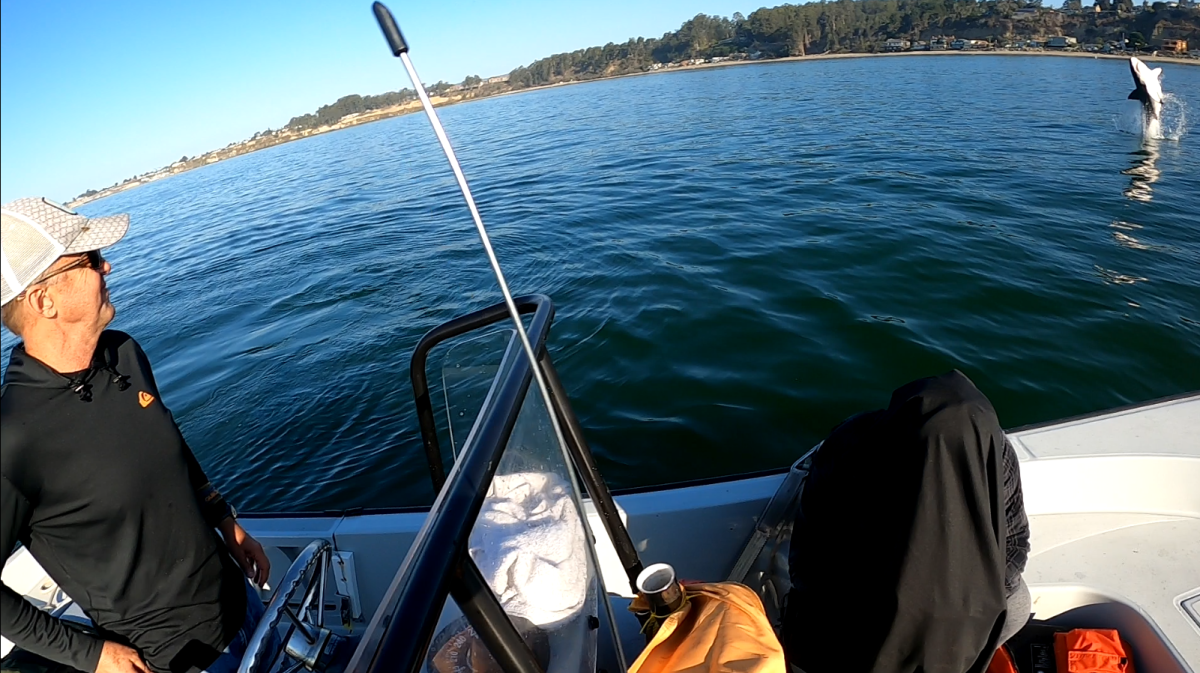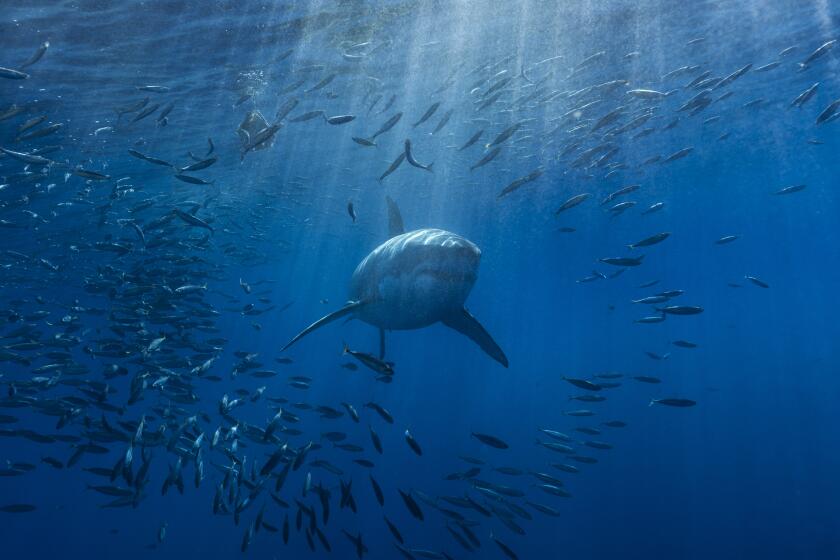Op-Ed: How juvenile white sharks in search of warmer waters disrupt life off the California coast

- Share via
Since 2014, when a marine heat wave scientists dubbed “the blob” encroached on the Central Coast, juvenile white sharks have been following warmer currents to waters they didn’t usually inhabit. The northern edge of the juveniles’ core range had been the Santa Barbara area, but it now stretches all the way to Monterey Bay.
It’s one more clear signal that climate change is dramatically altering ocean waters off the California coast.
The northerly shift in habitat of the juveniles — known in popular culture as great white sharks — has been documented by my scientist colleagues at the Monterey Bay Aquarium and their research partners at Cal State Long Beach. More than two decades ago, the team began using electronic tags to track the movement of more than 140 adult and juvenile white sharks.
Before exhibiting our first juvenile white shark in 2004, the aquarium wanted to conduct research to better understand these awe-inspiring and mysterious creatures of California’s waters. The data we collected have told us much more than we initially set out to discover.
One unexpected finding: an increase in reported sightings of juvenile white sharks in Monterey Bay, far north of their usual haunts — and essentially in the aquarium’s oceanic backyard — following “the blob” of warm water up the coast.
The Monterey Bay Aquarium tracked 79 juvenile sharks and found great whites have not only adapted to the perils of climate change, but thrived in them.
Long after the 2014-16 heat wave dissipated, juvenile white sharks have continued their summer migration to Monterey Bay to visit a consistently warm pocket of water at the bay’s northern edge. Sheltered from wind and waves, ocean temperatures there commonly reach 69 degrees during the late summer and fall, compared with the usual average bay temperature of 55 degrees.
The shift demonstrates that the young sharks are traveling farther north to find water in their preferred temperature range, which our research shows is between 60 and 72 degrees.
Previously, juvenile white sharks were found mainly in warm waters off Baja California and Southern California. In contrast, adult great white sharks have been returning to the Central Coast for decades; their ability to conserve body heat allows them to tolerate colder water than juveniles.
Scientists have added white sharks to the growing list of marine species, such as sea turtles or coral, whose life histories are being disrupted by climate change. As shifting ocean conditions expand juvenile white sharks’ geographic range, the ripple effects are altering fundamental relationships in coastal ecosystems.
Climate change is driving coral reef bleaching in the tropics, and algal blooms that cause fish die-offs in San Francisco Bay and other places. Along the Central California coast, the increased presence of juvenile white sharks appears to be having a lethal effect on another local population: sea otters.
They once numbered in the hundreds of thousands, inhabiting a wide arc of the northern Pacific Rim. In the late 1800s and early 1900s, fur trade and hunting drove sea otters close to extinction. Even today, California sea otters are classified as threatened under the U.S. Endangered Species Act, numbering only about 3,000 and occupying just 13% of their historical range, from Half Moon Bay to Point Conception.
Since the aquarium opened in 1984, we’ve been working to support sea otter recovery by rescuing injured and orphaned animals, rehabilitating them and returning them to the wild. But in the last decade, sea otter numbers have plateaued. One likely reason for the slowdown is the increased presence of juvenile white sharks in the heart of the sea otters’ range. Over the last two decades, the number of sea otters fatally bitten by sharks has tripled, from approximately 30 to more than 100 a year.
2020 will go down in history as the year Californians could no longer ignore climate change.
After their first bite, the sharks often discover that otters aren’t worth the trouble to eat. But it’s already too late for the otters — the encounter is frequently fatal. Scientists now consider shark bites one of the most significant limitations to southern sea otter recovery.
This in turn compromises California’s climate resilience. The natural prey of sea otters includes urchins in kelp forests and crabs in seagrass estuaries. By keeping these populations in check, sea otters contribute to thriving ecosystems, which then help increase biodiversity and allow coastal waters to serve as living buffers against the effects of climate change. Estuaries are also powerful carbon sinks, absorbing atmospheric carbon dioxide and storing it in the sediment.
Without the presence of sea otters, urchin and crab populations increase, which can lead to overgrazing of kelp forests and degradation of seagrass beds.
Of course, sharks are not the problem; the greenhouse gases that make the ocean warmer, more acidic and less oxygen rich are to blame. These climate change impacts are altering the fundamental structure of the ocean’s chemical, physical and ecological systems, with devastating consequences to ocean life and the health of our planet.
The ocean is the blue heart of our climate system. By speeding up the global transition to clean energy, and protecting and restoring coastal ecosystems, we can better position ourselves to weather the climate crisis. In the process, we can improve the odds of survival for sea otters, sharks and all of the other magnificent and vulnerable marine life.
Aimee David is vice president for U.S. and California Ocean Conservation at the Monterey Bay Aquarium.
More to Read
A cure for the common opinion
Get thought-provoking perspectives with our weekly newsletter.
You may occasionally receive promotional content from the Los Angeles Times.












